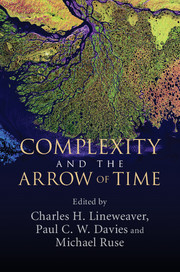Book contents
- Frontmatter
- Contents
- Author biographies
- Part I Introduction
- Part II Cosmological and physical perspectives
- 2 Directionality principles from cancer to cosmology
- 3 A simple treatment of complexity: cosmological entropic boundary conditions on increasing complexity
- 4 Using complexity science to search for unity in the natural sciences
- 5 On the spontaneous generation of complexity in the universe
- 6 Emergent spatiotemporal complexity in field theory
- Part III Biological complexity, evolution, and information
- Part IV Philosophical perspectives
- Index
- References
2 - Directionality principles from cancer to cosmology
from Part II - Cosmological and physical perspectives
Published online by Cambridge University Press: 05 July 2013
- Frontmatter
- Contents
- Author biographies
- Part I Introduction
- Part II Cosmological and physical perspectives
- 2 Directionality principles from cancer to cosmology
- 3 A simple treatment of complexity: cosmological entropic boundary conditions on increasing complexity
- 4 Using complexity science to search for unity in the natural sciences
- 5 On the spontaneous generation of complexity in the universe
- 6 Emergent spatiotemporal complexity in field theory
- Part III Biological complexity, evolution, and information
- Part IV Philosophical perspectives
- Index
- References
Summary
THE BIG PICTURE
One of the gloomiest scientific predictions of all time was made in 1852 by the physicist William Thompson (later Lord Kelvin) (Thompson, 1852). From a consideration of the laws of thermodynamics, and the nature of entropy, Thompson declared that the universe is dying. The second law of thermodynamics, which had been formulated a few years earlier by Clausius, Maxwell, Boltzmann and others (see, for example, Atkins, 2010), states that in a closed physical system, the total entropy – roughly a measure of disorder – can never decrease. All physical processes, while they may produce a fall of entropy in a local region, always entail a rise of entropy somewhere else to pay for it, so that when the account is tallied, the total entropy will be seen to have risen. Applied to the universe as a whole, the second law predicts an inexorable rise of the overall entropy with time, and a concomitant growth in disorder. The one-way slide of the universe towards total disorder – popularly known as the heat death of the universe – imprints upon it an irreversible arrow of time. One need look no further than the Sun, slowly burning through its stock of nuclear fuel, radiating heat and light irreversibly into the cold depths of space, to see an infinitesimal contribution to the approaching heat death. Eventually its fuel will be exhausted, and the Sun will die, along with all other stars when their time has come. The sense of futility and pointlessness that the dying universe scenario engenders in some commentators was eloquently captured by Bertrand Russell in his book Why I Am Not a Christian (1957) and has been echoed in recent years in the writings of Peter Atkins (1986).
- Type
- Chapter
- Information
- Complexity and the Arrow of Time , pp. 19 - 41Publisher: Cambridge University PressPrint publication year: 2013
References
- 6
- Cited by



